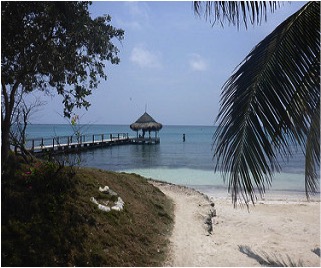Isla Grande
Isla Grande, Bolívar, Colombia
Isla Grande is situated in the Caribbean Sea alongside one of the largest marine protected areas in Colombia: the Corales del Rosario and San Bernardo National Natural Park (CRSB-NNP) and the Corales del Rosario, San Bernardo & Isla Fuerte Marine Protected Area (CRSBIF MPA). Isla Grande’s current population of Afro-Colombian descendants approximates 1000 people. For 300 years, these people have continuously shaped, and been shaped by, its relations with the surrounding coral reef, mangrove seascapes, internal lagoon, and dry forest landscapes. Consequently, over generations, relationships with place have evolved through the community’s knowledge, innovations, and practices that are intimately linked with territory, biological diversity, cultural and spiritual values—or their collective biocultural heritage. Place is thus a testament of the community’s history, present-day lives, and future.
Top environmental challenge faced by the community (currently or in the past 10 years):
Although protected areas are globally significant to protect biodiversity and associated human culture, they are not without their challenges to support entangled and diverse place relations. In the case of the CRSB-NNP, ethnic minority communities living within and alongside this protected region (i.e., Indigenous, Afro-Colombian, and peasant communities) face many socio-ecological issues related to balancing multi-actor interests, rights, and practices in connection with sustainable development. Predominant issues in the region include boundary establishment and disregard for territorial rights; limited institutional capacity and funding; top-down approaches and disjointed policies; the commodification of nature and local communities for tourism, combined with private concessions; resource competition; unmonitored development; illegal activities such as dynamite fishing and drug trafficking, and low economic status of the community. The overarching challenge is constraint on expressions of collective biocultural heritage and endogenous development practices of local communities, as well as a need for collaborative models of sustainable development.
How the environmental challenge has affected local livelihoods:
Socio-ecological challenges in the region have resulted in decreased integrity of biocultural relationships of Isla Grande community members, often leading to unsustainable practices. Traditional fishing practices have been supplemented by tourism, a burgeoning primary source of income with up to 2000 visitors/day during high season. The challenge is encouraging sustainable tourism development within the community, alongside protected area co-management and environmental education. This is particularly important when external pressures may value local biological and cultural heritage as a commodity or service (e.g., for tourism appeal). This can compound local socio-ecological issues through foreign direct investment, product differentiation, and otherwise capitaliz[ation] upon cultural resources for sustainable development. Critical attention must be paid to the role of autonomous development to ensure biocultural ethics, rights, and responsibilities. Biocultural heritage innovations and designs may be a means toward these ends, by emphasizing community knowledge, interests, and practices, thereby creating collaborative tourism products and services.
Community response to the challenge, through environmental stewardship (conservation) initiatives that improve environmental well-being and support sustainable livelihoods:
Disregard for territorial rights has lead to the community's 17-year social movement toward self-determination and sustainable development. Through a history of colonization, slavery, and marginalization, the Afro-Colombian people of Isla Grande have shaped, and been shaped by, ancestral territory places. Particularly, interdependent relationships have evolved to intimately link biodiversity of the region with community knowledge, innovations, practices, capabilities, and values. Respect for these entangled relations has motivated the community’s movement to (re)imagine ways of reconciling, renewing, and (re)generating place relationships and capabilities to address socio-ecological challenges. Efforts have included participatory planning; non-formal education such as eco-guide entrepreneurial ventures, environmental interpretation training, and cultural revival activities, as well as local, organizational, and legal council collaboration to shape a Plan de Vida, or life plan. An emergent document arising through collective learning processes, this Plan outlines ancestral territory rights and commitments toward sustainable development.
Extent to which governmental policy (at local, regional or national levels, as relevant) has supported, or been contrary to, the community's responses to the environmental challenge:
In 2001, a policy of public participation for conservation was implemented by the Corales del Rosario National Park authorities. Environmental discourse began to promote Native Islander welfare and their future in their territory. However, at the same time, natives were declared “invaders” of the islands, without taking into account their historical presence and land/sea use. As a result, the community began efforts toward self-determination, and in 2006 they appealed to the legal precedence of a national law that recognizes ethnic minorities and ancestral territory rights in conservation and sustainable development practices (i.e., Law 70/1993). Law 70 was instrumental in legitimizing the growing social movement to recognize Afro-Colombian identity across Colombia. Today, efforts to uphold Law 70 in Isla Grande are a means to address predominant place issues established through the CRSB-NNP designation, and thus to promote culturally- and experientially-driven knowledge, strategies, and priorities. Moreover, community efforts assert biocultural interdependence and the diverse ways place is understood and experienced—even among Islanders themselves.
Keywords: Ecosystem
Agricultural, Coastal, Forest, Mangrove, Marine
Keywords: Resources
Air, Fish, Forest, Wildlife, Water
Keywords: Big Issues
Biodiversity, Climate change, Education, Environmental law, Human-wellbeing
Keywords: Solutions
Ecological Restoration, Governance/Management, Local/Traditional knowledge, Policy and planning, Public participation
Contributed by: Jennifer McRuer, Alliances for Abundance; MINGAS for Transition
The information provided and opinions expressed above are the responsibility of the contributor and do not necessarily reflect the views and analysis of the Community Conservation Research Network (CCRN), nor those of all members of the community described.
For any questions or comments on Communities in Action, please contact us
here.



